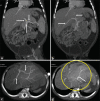Previously Undescribed Anomalies of Hepatic Artery and Portal Venous Anatomy in a Case of Extrahepatic Biliary Atresia and its Implications
- PMID: 31571764
- PMCID: PMC6752067
- DOI: 10.4103/jiaps.JIAPS_132_18
Previously Undescribed Anomalies of Hepatic Artery and Portal Venous Anatomy in a Case of Extrahepatic Biliary Atresia and its Implications
Abstract
A search on PubMed and Web of Science revealed scarcity of the literature on anomalies of hepatic artery or portal vein and the presence of arterioportal fistula in biliary atresia; although, it has long-lasting implications for both the patient and the surgeon, including hepato-pancreato-biliary surgeons, pediatric surgeons (who perform Kasai's portoenterostomy), liver transplant surgeons, and interventional radiologists. We report a case of extrahepatic biliary atresia with multiple anomalies involving the hepatic arteries, portal vein, cystic artery, arterioportal fistula and shunting, intrahepatic portal vein radicals, kidney, and external genitalia. The merits of the case from various standpoints including its implications for etiopathogenesis, caution during surgical anesthesia or postoperative management, and enrichment of the literature have been discussed.
Keywords: Anomalies; arterioportal shunting; congenital; extrahepatic biliary atresia; hepatic artery; hypospadias; liver transplant; portal vein; renal agenesis.
Copyright: © 2019 Journal of Indian Association of Pediatric Surgeons.
Conflict of interest statement
There are no conflicts of interest.
Figures


References
-
- Cowlis RA. Coran AG. Pediatric Surgery. 7th ed. Philadelphia: Elsevier Saunders; 2012. The jaundiced infant: Biliary atresia; pp. 1321–30.
-
- Guttman OR, Roberts EA, Schreiber RA, Barker CC, Ng VL, et al. Canadian Pediatric Hepatology Research Group. Biliary atresia with associated structural malformations in Canadian infants. Liver Int. 2011;31:1485–93. - PubMed
-
- Braun MA, Collins MB, Wright P. An aberrant right hepatic artery from the right renal artery: Anatomical vignette. Cardiovasc Intervent Radiol. 1991;14:349–51. - PubMed

